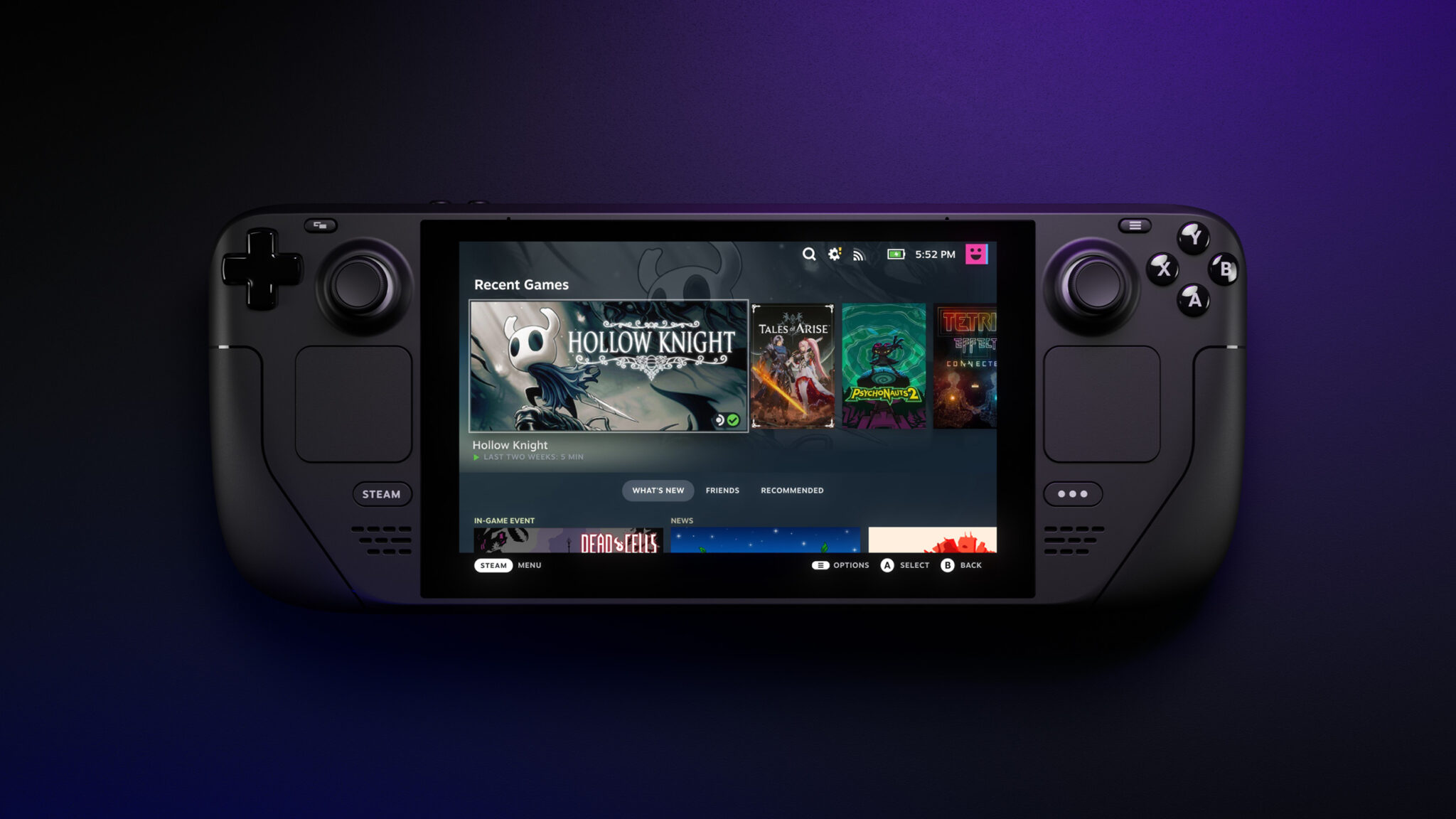
Steam Deck Review: High-end handheld gaming – but only for the well-off
Before we go any further, it’s really important to establish that the Steam Deck is not an entry level portable gaming device. At £569 ($649) RRP, the top-end Steam Deck with a 512GB NVMe SSD – the version being reviewed here – costs more than a PlayStation 5 or an Xbox Series X (£449/$499 RRP). It costs nearly double the price of a Nintendo Switch OLED (currently £309.99/$349.99 RRP). Even the cheaper models aren’t that cheap – the lowest offering, at £349/$399 with only 64GB eMMC storage, still costs more than a Switch OLED, while at £459/$529, the mid-range model with a 256GB SSD still costs more than a PS5 or XSX.
By any measure, the Steam Deck is a phenomenally expensive gaming device – yet with a waiting list of months for customers to get their hands on a unit directly from Valve, it’s already a success despite the price. But does this much-hyped handheld gaming PC actually warrant the buzz surrounding it?
In short, unless you have deep pockets, probably not. It is, undeniably, the best way to play PC games on the go, but it’s marred by curious design choices, worrying performance issues, and – thanks to the still-unreleased official dock – a sense that early adopters are being asked to pay for a premium product but receiving an unfinished one for their coin.
Design and Build Quality
To Valve’s credit, the Steam Deck is a lovely piece of kit. The build quality is great, with the sleek black unit looking and feeling like it deserves its premium price. Where other manufacturers have offered “handheld gaming PCs” before, they’ve often been glorified kit-bashes of loosely assembled tech; in comparison, the Steam Deck offers a unified approach that feels far more considered, designed from the ground up to make PC gaming in a portable form factor truly viable.
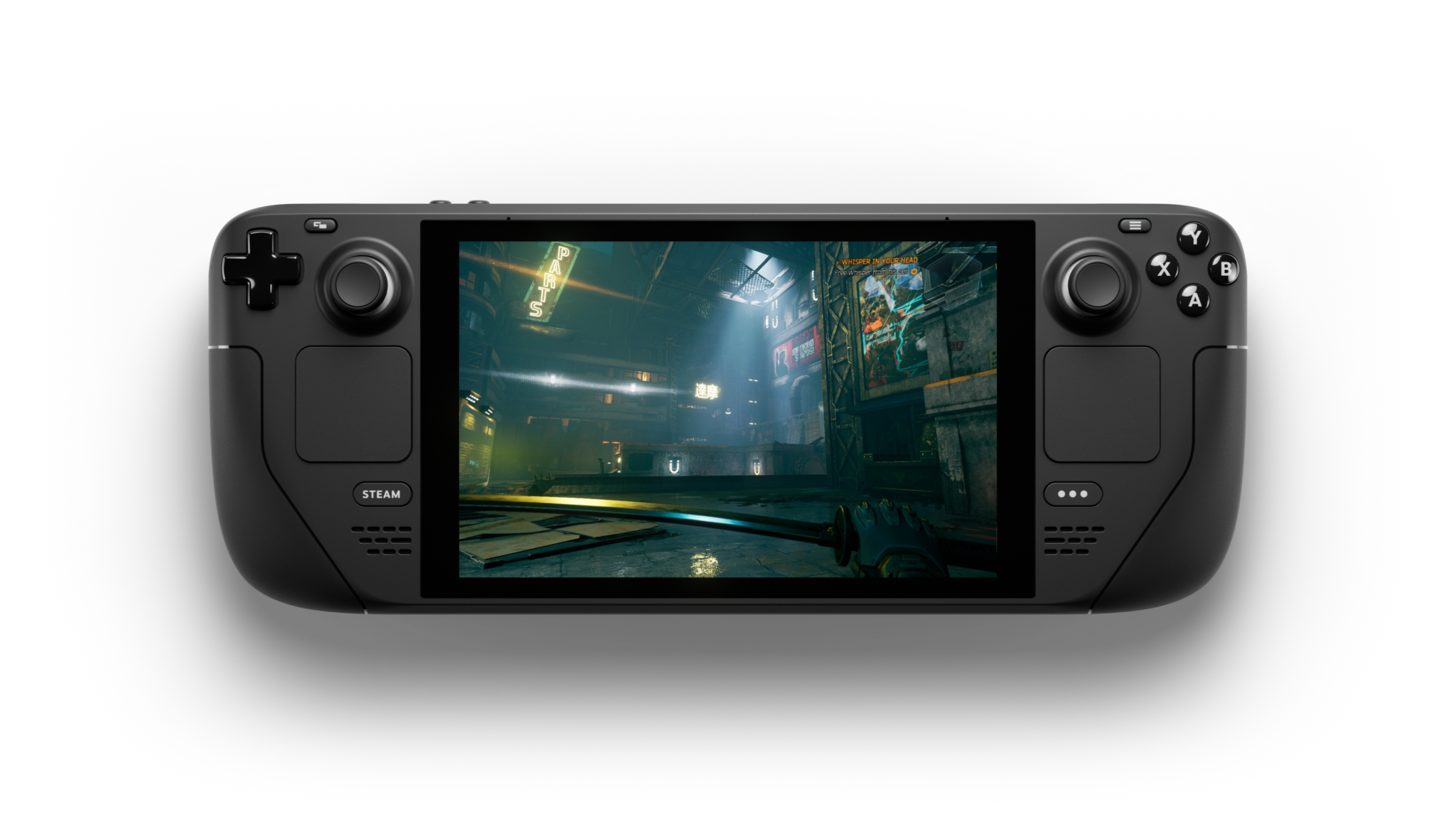
It’s all the more impressive when you consider just how much tech Valve has crammed in, too. On top of the 1280×800 pixel, 60Hz touchscreen that takes up the majority of the surface real estate of the Steam Deck, Valve has incorporated all the controller inputs you’d expect on, say, a standard Xbox joypad – A, B, X, Y face buttons, twin thumbsticks, shoulder buttons and triggers – plus dual trackpads, gyroscopic controls, capacitive sensors on the thumbsticks, and four extra input buttons on the underside of the Deck, which can be customised on a per-game basis for quick controls or improved accessibility options. The assorted inputs anticipate almost every way players would want to engage with PC games on the go, and leaves freedom to personalise the experience for any that may have been overlooked.
That 1200×800 screen, in a 16:10 aspect ratio, looks great. While it’s slightly disappointing that the Steam Deck doesn’t offer full HD on the go, especially for the price it’s asking for, that would have likely meant even more of a battery drain – already a major problem; see below. As is, the screen offers sharp visuals and solid colour depth, and when games are hitting that 60Hz refresh rate, they look silky smooth. It’s also solid on the audio front, with built-in stereo speakers that target sound at the player, plus support for both Bluetooth headphones and a 3.5mm jack for wired headphones. While the in-built speakers can be a little tinny at times, headset audio sounds great.
Best of all is that, despite everything it packs in on the hardware front, it doesn’t feel too heavy in the hands. It’s a wide unit though, at 298mm, and weighs in at just shy of 700g. Although it can start to strain wrists after a while, it feels almost miraculous that it’s as light as it is.
However, its design isn’t flawless. The outermost face buttons – the B button on the right, and the D-Pad on the left – are at such extremities that they feel as if they’re almost hanging off the edge of the console itself, while the power and volume buttons are generally out of reach without having to change grip. It’s far from ideal to have to pause a game just to adjust the volume. The plastic of the D-Pad and ABXY buttons feels cheap too, and seems to pick up micro scratches just from casual use.
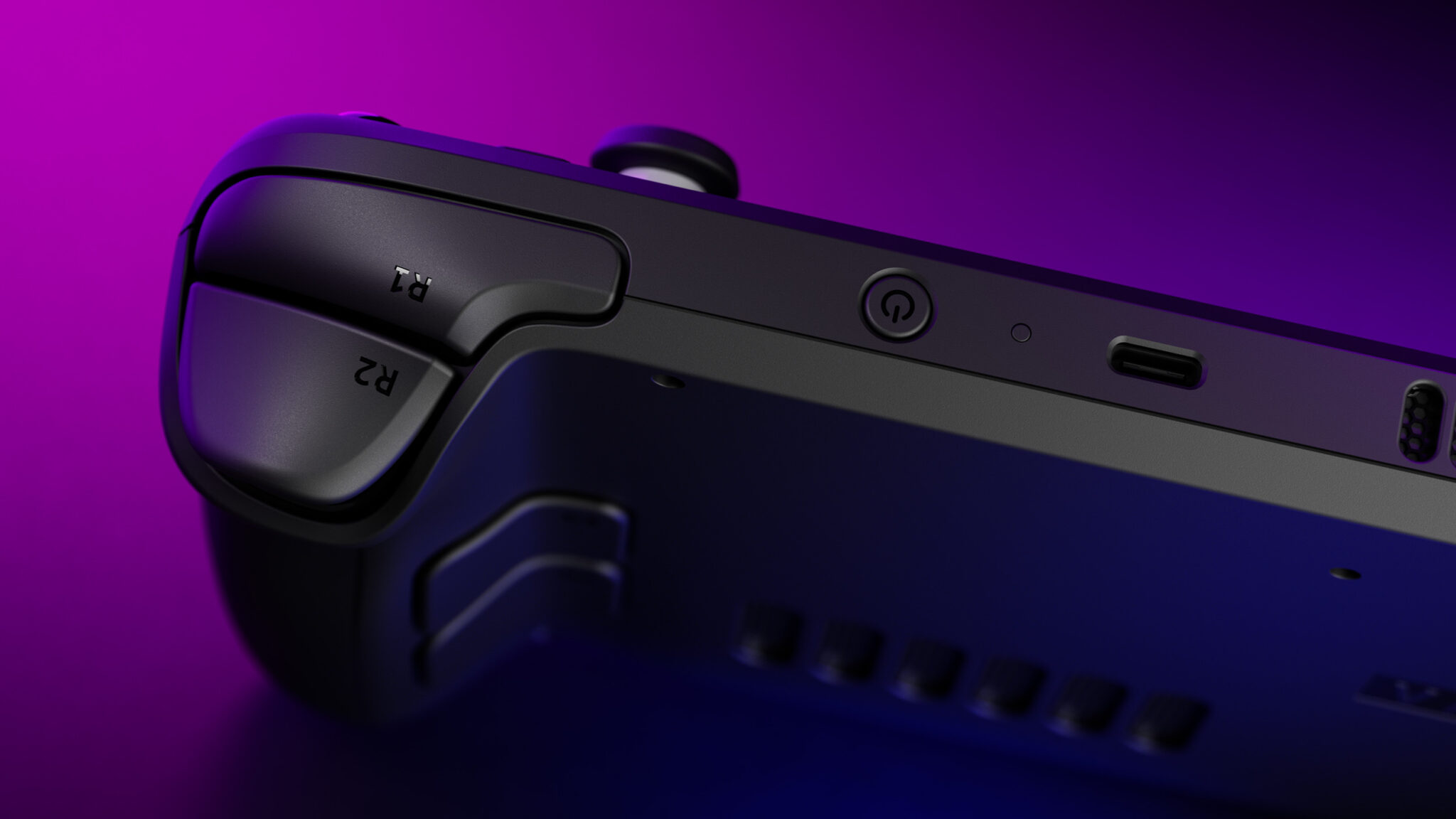
Perhaps the most baffling design aspect though is the aggravating combination of the positioning of the USB-C charging port, which rests on the top edge of the Steam Deck, and the layout of the carrying case that the Steam Deck ships in. Without any official dock to rest or charge the console in when not in use, the logical choice for many users would be to leave the Steam Deck to safely charge in its case – especially useful if you’re out and about and need a charge while keeping the hardware protected from knocks, scratches, spills, and other perils of the outside world.
However, this is essentially impossible. The way the console sits in the moulded case has the upper edge against the fold of the case, meaning there’s no way to fit the console in while charging, as the USB-C charger will prevent the case closing. It also means that, whenever the official dock is released, it’ll need a fiddly extension cord to plug into the power port at the top, rather than having the Deck neatly resting on a charging connector as the Switch does on its dock. It’s frustrating that such a small design choice – the placement of the USB-C port – can have such a dramatic impact on the actual functional usage of a device, but the seeming lack of consideration for how people will use the Steam Deck in the real world adds to the sense of having an unpolished, unfinished product.
Experience and Games
Although, in Valve’s own words, “Steam Deck is a PC so you can install third-party software and operating systems”, here we’re looking at the hardware in its default form, as a way to provide portability to players’ Steam libraries. The main user interface is Valve’s SteamOS 3.0, which does a successful job of streamlining the often-bloated desktop Steam client into an easily navigable in handheld form. If you’re coming to Steam Deck from a more conventional gaming laptop or desktop – and chances are, you will be – it’ll all be immediately recognisable. Even for newcomers, it’s a simple and intuitive layout, though it does have a few quirks that make it more intimidating than the elegant minimalism of the Switch’s UI, or even the PS5’s.
The Steam Deck’s Home screen offers a list of recent games, allowing you to quickly jump between titles. However, unlike the Switch, it’s advisable to manually close down one game before starting another – while you’ll get a warning that another title is still running and that it could affect performance, you won’t be prompted to close it. It’s also slightly confusing that the recent games view seems to be aggregated across all platforms your Steam account has been active on, meaning it might show a game in the list that you’ve played on a desktop that isn’t actually installed on the Steam Deck.
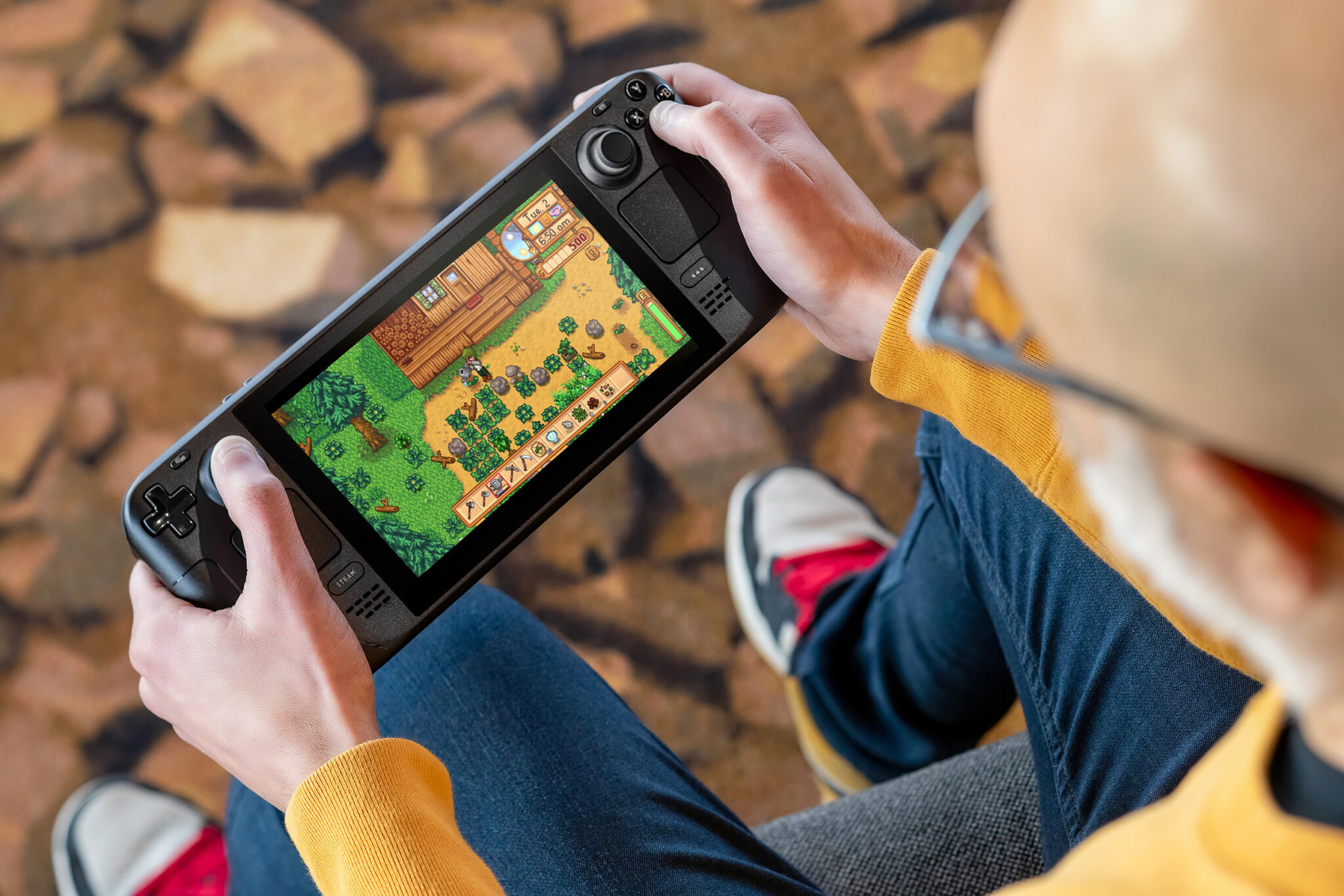
Thankfully, installing games is a cinch. Tap the dedicated physical Steam menu button at the bottom left of the screen, select or tap Library, and you’ll get an instant view of all games linked to your account. Valve has already created a “Great On Deck” filter, for games that it’s verified will run on the hardware. A similar section is provided in the Steam store, allowing you to buy games that are guaranteed to play. Then it’s a simple matter of either tapping the Option button and selecting “install”, or going into the game’s dedicated page – where you’ll be able to see detailed information, including screenshots you’ve taken, friend activity on the game, and more – and doing the same. Once installed, you’ll be able to jump right in, with game saves carried over from the cloud to allow you to pick up on Deck where you left off on the desktop.
You’re not limited only to the “Great On Deck” selection though – go to the “All Games” screen and every game you own is available to install. Each title will be marked with either a tick indicating compatibility, a question mark that means Valve can’t yet confirm functionality, or a block symbol, which technically means a game won’t run on Steam Deck.
This is where things start to get a little confusing, as that “technically” means there are games that officially won’t run that actually will in practice. Classic Falcom JRPG The Legend of Heroes: Trails in the Sky is one such game, marked as incompatible but it plays just fine. It may simply be that Valve’s verification system has a massive backlog – unsurprising if so, given how many games are available on Steam – but it does mean figuring out which games you can and can’t play on Deck feels like a crapshoot. It feels like a hangover from the ‘Wild West’ nature of PC gaming as a whole – on almost no other format could you expect to browse your game library and not know for sure whether a game will run or not.
Overcome all that though, and the games are, appropriately, where Steam Deck shines brightest. Everything just seems to work, with any games that use a conventional controller layout mapping instantly to the Steam Deck’s inputs. Being able to pick up where you left off thanks to cloud saves – and vice versa, continuing your Deck gaming at home – is a delight, too. The first game we tried out was a brand new one though: Aperture Desk Job, Valve’s free mini-game tailored to Steam Deck. Narratively, it’s a must-play for fans of Portal, with a long-overdue return trip to the depths of Aperture Science that reveals a surprisingly pivotal development in the series’ lore. More importantly, it serves as a demo of all the Steam Deck’s various hardware features, guiding users through the Deck’s many tricks and making it worth returning to on occasion for a fun reminder of less-used ones.
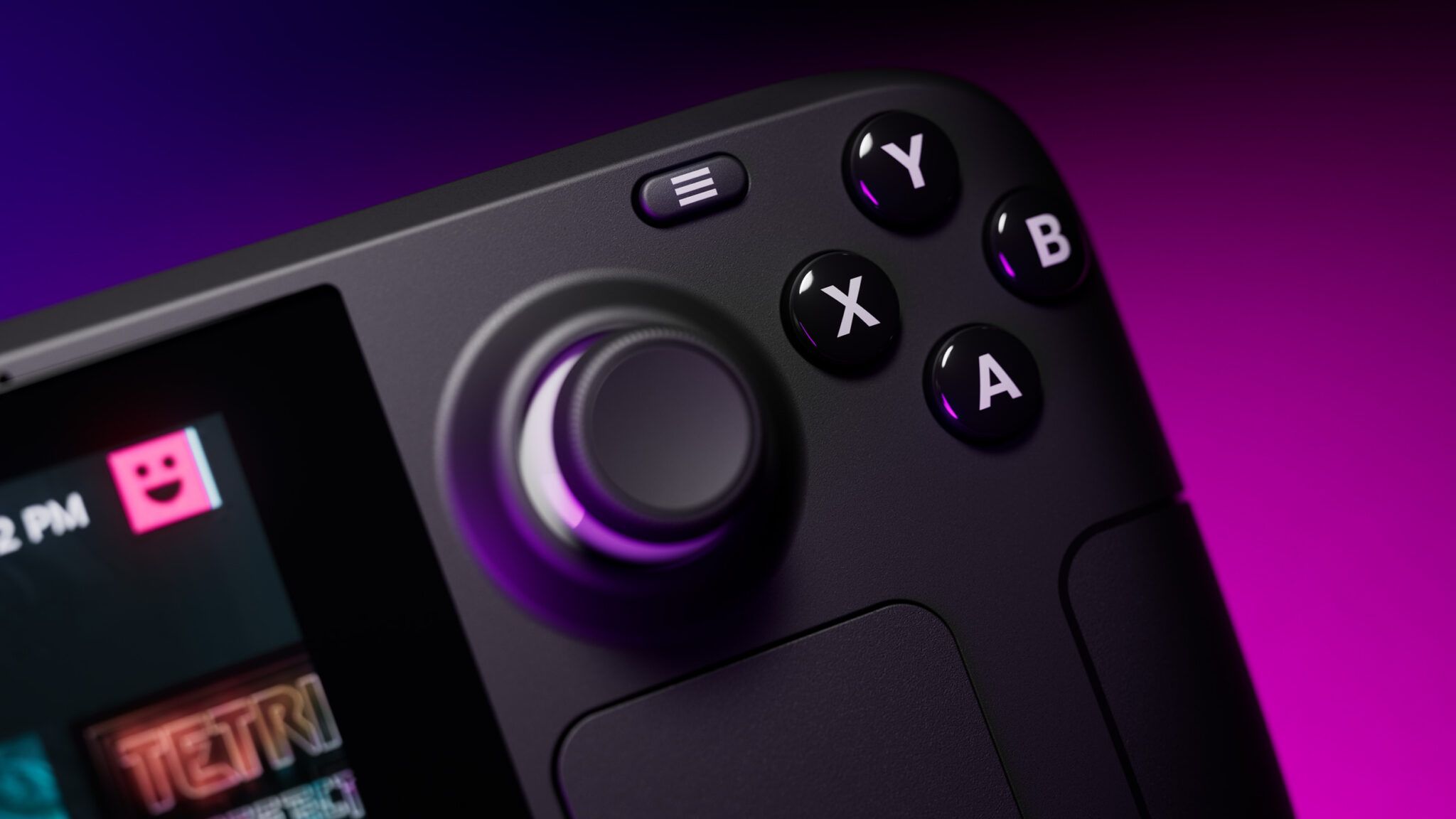
It’s remarkable just how tactile playing games on Steam Deck feels, thanks to an incredible range of haptics. Valve calls it “HD Haptic”, and while it’s not provided more specific details, the rumble that rolls through the entire handheld adds a considerable layer of immersion. It’s not just action-responsive vibration though: those dual trackpads – enabling cursor movements on the Steam Deck and making the likes of city builders, point-and-click adventures, or any other mouse-mandated games playable – have a satisfying tremor as you move your thumbs over them.
In a particularly nice touch, you can also use the trackpads to type on the onscreen keyboard, with each side covering roughly half the keyboard and letters selected by pressing in on the pad. It takes a little while to get used to, but you’ll soon be tapping out messages in in-game chat faster than you can WhatsApp your besties.
Performance
Impressively, Steam Deck handled just about every game we threw at it without any significant problems. For queer gamers in particular, the plethora of indie games that explore LGBTQ+ themes will run like a dream, making everything from Boyfriend Dungeon and Coffee Talk to Monster Prom and Chasing Tails accessible on the go. Even titles from bigger studios, such as Life is Strange: True Colors ran great.
The Steam Deck did seem to struggle with some very high-end games, such as Horizon Zero Dawn and space shooter Chorus, but even in these cases the worst we noticed was some lagging frame rates and, rarer, some slow down. For the most part, even these graphically demanding titles still ran well. It’s particularly tempting to forgive Horizon its occasional flaws as the ability to play one of Sony’s biggest first-party games on a handheld console – something Sony itself doesn’t offer in this post-Vita era – is simply astonishing.
A worrying part of the Steam Deck though is its heat generation. The fan runs loud and hot, even after installing the most recent software update that ostensibly better regulates it. Even just leaving the Deck to install a game sees temperatures rising to disconcerting levels – the back of the console gets distressingly warm to the touch, while the jet of air pumped out of the vents is hot enough to warm your hands on a cold winter day. It can get hotter still when playing a demanding game.

This isn’t helped by the lack of a dock. Without a ‘home’ for it to sit in, most people are likely to either leave the Deck in the case while games are installing, which cuts down on ventilation even when the case is left open, or place it on a table or counter. While the latter offers better air flow, having the hardware laying flat means hot air is pumped out horizontally, which is less efficient for heat dissipation. Hopefully, future software updates can improve fan performance further, because the heat issues at present are truly concerning.
Battery life is Steam Deck’s biggest failing though. Despite containing a 40Whr battery, usage time in real-world conditions typically fell far short of Valve’s claims of two-to-eight hours of gameplay. Just installing games can significantly drain the battery – downloading Horizon: Zero Dawn took the Steam Deck’s battery from full down to 65 per cent over the course of 42 minutes. Actually playing the game – admittedly one of the more demanding titles available on Steam at present – ran down the remainder rapidly, bringing up the “low battery” warning (which kicks in at 10 per cent) after a mere 25 minutes.
Less demanding games predictably fare better – Eiyuden Chronicle: Rising, a 2D side-scrolling action RPG, enjoyed around three hours of play before needing a charge, while fan-favourite adventure game Lake managed about the same. Classic point-and-click Broken Sword: The Director’s Cut and visual novel/puzzle hybrid Murder by Numbers eked out just over four hours. Nothing even came close to Valve’s top-end claim of eight hours of play though.
Disappointingly, the Steam Deck doesn’t do a great job of energy conservation, either. Even in rest mode, the battery dropped from fully charged to a mere 35 per cent in about five hours (with Eiyuden Chronicle: Rising held in a suspended state). This isn’t ideal for travelling gamers – even if you leave home with the Steam Deck fully charged, it may have run down by the time you board a train or plane. Thankfully, it does seem to charge reasonably quickly – back up to 65 per cent from the 10 per cent warning level in an hour in our tests, using the included official charger – but if there’s nowhere to get a charge, your expensive gaming machine turns into a paperweight alarmingly quickly.
Conclusion
In many ways, the lack of an official dock is the Steam Deck’s biggest stumbling block. Not only could it help mitigate some of the cooling and battery issues, but it would also enable some of the hardware’s full potential to come through. The Deck can supposedly output up to 8K resolution at 60Hz, or 4K at 120Hz, but that spectacle feels locked off at present. Although any powered USB-C hub can output the Steam Deck to an external monitor or TV, it’s an inelegant and imprecise solution. Plus, whether you use a third-party solution or wait for Valve’s official dock (expected in “late spring 2022”, but it’s already June 2022 at time of writing, with no sign of release), there’s no escaping that buyers are on the hook for a peripheral that should really have been included. Again, for the prices Valve is asking for the Steam Deck, it’s an unacceptable omission.
On the software side, despite it streamlining the PC gaming experience into a form more oriented towards traditional console players, the Steam Deck still isn’t as convenient or accessible. This may improve with time, particularly as Valve verifies more games as Deck compatible, and as developers make games with Deck compatibility in mind, but at present it’s a bit of a mess.
In its present form, Steam Deck is more likely to appeal to existing hardcore PC gamers – those already used to spending potentially thousands on a gaming rig, who want a niche hardware extension. For anyone else, it’s probably best to wait for a second generation model that will hopefully, at the very least, improve battery life and cooling – this is for early adopters only.
Ultimately, Steam Deck is not for anyone looking for an entry point to PC gaming – it’s a luxury purchase through and through. However, between the poor battery life, worrying heat issues, and design choices that make using, storing, and charging the hardware fiddly, it’s sadly not luxurious enough to justify those premium price tags.




